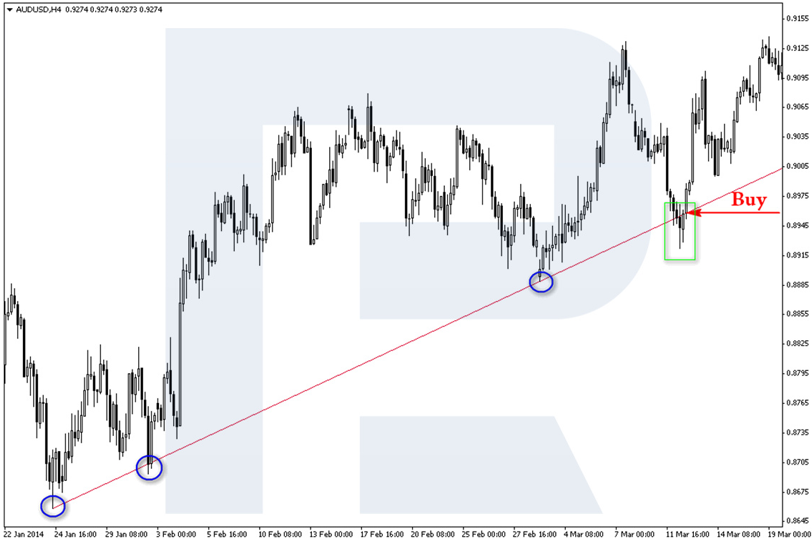Understanding trendlines
This strategy was invented by a market trader who aimed at maximum simplicity and equally high efficacy. The author trades trendlines on all Forex instruments and currency futures. As for timeframes, suitable ones are H4, D1, and W1.
A signal to buy by an ascending trendline
This original system stands on two whales: trendlines and the Engulfing candlestick pattern (in bas, this pattern is called Rails). For a signal to buy to emerge, the following circumstances are required:
1. there is a directed upwards movement; to prove it, you need to draw a trendline through two or more local extremes;
2. the price must bounce off the trendline of the Engulfing pattern;
3. if the Engulfing pattern, bouncing off the ascending trendline, has formed on H4, on D1 and W1 the current candlestick and two preceding ones must not be included in an opposite Engulfing pattern, otherwise the trendline might fall prey to the countering signal of a larger timeframe.
On your working TF, the current candlestick and two preceding ones must neither be parts of an opposite engulfing pattern. If there was an Engulfing three or more candlesticks ago, the signal is considered valid.
An example of a signal to buy by an ascending trendline

Though the Engulfing pierced the trendline, the last one of the two candlesticks forming the price pattern closed one tick above the trendline. This means the signal can be used for entering a long position. By the way, in the example above you can see that you may cut off some shadows when drawing the trendline for the final line to have more touches, which means more significance.
A signal to sell by a descending trendline
For such a signal to form, we need the following conditions to be met:
1. there must be a pronounced bearish trend with at least two local highs through which you will draw a trendline;
2. the Engulfing candlestick pattern must bounce off the bearish trendline;
3. the current candlestick and the preceding two ones on the working TF must not be a part of a bullish Engulfing pattern; same on larger TFs of the chart.
An example of a signal to sell by a descending trendline

This example boasts two subsequent signals to sell. When such a thing happens, a signal to enter the market is enforced.
Stop Loss and Take Profit when trading trendlines
Place an Stop Loss behind the bouncing Engulfing pattern. However, if you have doubts about what is going on, you may place an SL behind the farthest local extreme or a round pattern, if there is such one nearby.
Follow the position by transferring your SL to newly emerging local extremes while the price is approaching the profit.
Place a Take Profit before the nearest important support/resistance level. Round patterns in this strategy also count as strong support/resistance levels. Hence, if a round pattern is even closer to your position than a graphic support/resistance level, place your TP before the former. Moreover, in this strategy, apart from traditional support/resistance levels, the deepest bottom of the current downtrend is considered a support level, while the highest top of the current uptrend is said to be a resistance level.
Money management in trading by trendline
Money management: risk a fixed percentage of your deposit in each position, something between 1-2%. If you are already in the market by one order, and there is a signal to open one more, use it only if your current order has already been transferred to the breakeven.
An example of trading by trendlines

As long as the strategy is used on H4 minimum, it suits even those who are busy during workdays. And if you opt for D1, such trading will suit you in any case. However, on D1, there much fewer signals than on H4, especially with the currency market featuring a limited number of instruments. As for me, classical tech analysis works much better with futures and, of course, stocks. Anyway, I do not have any statistics of the efficacy of this strategy for futures and stocks.
By Dmitriy Gurkovskiy, Chief Analyst at RoboForex




